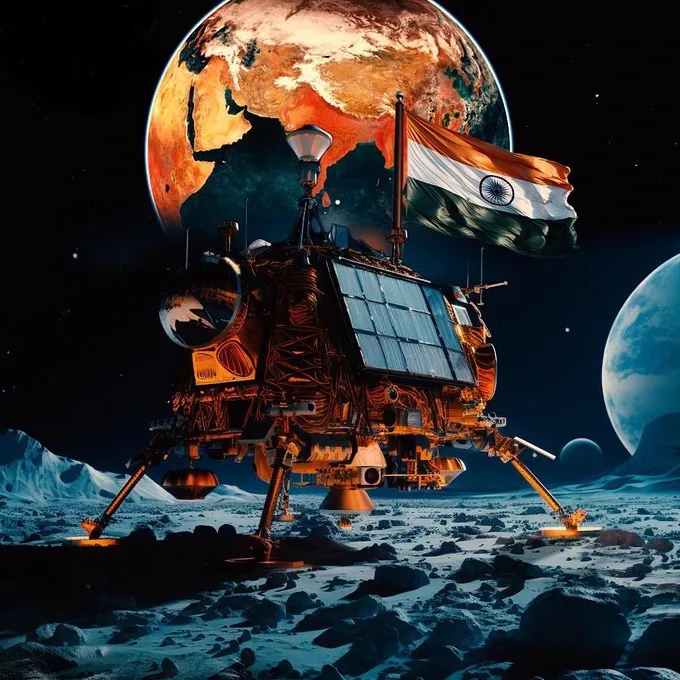By Ramakant Chaudhary…
India is over the moon! The historic month-long space odyssey culminated in an epochal success, marking a monumental achievement for human’s space exploration. Literally dawn breaks over the dark lunar South Pole as India’s Vikram lander on August 23, 2023 has started tunneling through the wispy atmosphere of the Moon. The success of Chandrayaan 3 reminisced the drawl of American astronaut Neil Armstrong, who became the first person to walk on the Moon in 1969, that “A small step for Man, a giant leap for mankind”. This is a small step for the Indian Space Research Organization (ISRO) and a giant bounce for India in the Amrit Kaal. 1.4 billion Indians feel proud to have taken the proverbial “Hanuman Leap” to the Moon, catapulted India to the elite club of US, Soviet Union and China becoming the fourth country to have deployed a rover on the lunar surface.
The meticulous planning, cutting-edge technology, government support, and unwavering dedication of the entire team of ISRO under the stewardship of Sreedhara Panicker Somanath converged to orchestrate this remarkable feat. The momentous event unfolded as Vikram lander executed a flawless descent onto the lunar surface to allow rover Pragyan to explore, touching down with a grace that belied the immense complexity of the endeavor. The significance of this achievement cannot be overstated. It not only solidifies India’s position as pioneers in space exploration but also demonstrates the country’s unwavering commitment to pushing the boundaries of human knowledge and capability. The successful landing has underlined the power of human innovation and collaboration, transcending borders and uniting humanity in the quest to uncover the mysteries of the cosmos.
The flawless execution of the landing owes much to the precision of ISRO’s navigational systems, which guided the Chandrayaan 3 through the challenges posed by the Moon’s unique gravitational conditions and rugged terrain. The moment of touchdown was met with a collective breath held around the world, and as confirmation of success reached around, jubilation erupted and happiness skyrocketed among the team members, dignitaries, space enthusiasts and people alike. It also vividly reflects: When India resolves and harnesses its collective intellect, nothing could eclipse such a sort of remarkable achievement. This historic landing not only marks a triumph for the nation but for humanity as a whole. It symbolizes the unyielding spirit of exploration that has driven Indians to venture beyond the earthly confines, igniting curiosity and fueling ambitions for the future.
Chandrayaan 3: What will lander Vikram and rover Pragyan do after touchdown?
The lander Vikram (Named after Vikram Sarabhai, the Indian physicist regarded as the father of the Indian space programme) and rover Pragyan (Sanskrit word meaning wisdom), are components of Chandrayaan 3 mission with specific objectives and tasks planned for their activities on the lunar surface after touchdown.
Vikram Lander
Surface study: After a successful soft landing, the Vikram lander has begun its operations by conducting a thorough analysis of the lunar surface. This includes studying the composition of the soil, examining the terrain, and assessing any potential hazards.
Payload Operations: Vikram is equipped with scientific instruments and payloads designed to study the moon’s composition, seismic activity, and thermal characteristics, which will gather data and transmit it back to Earth.
Deploying Pragyan: The primary objective of Vikram is to safely deploy the Pragyan rover onto the lunar surface. The rover, housed within the lander, has started rolling out onto the moon after the successful landing.
Pragyan Rover
Exploration: Pragyan is designed to be a six-wheeled robotic rover capable of moving across the lunar surface. Its primary task is to explore the terrain, analyze samples, and conduct experiments to understand the Moon’s geology and mineralogy.
Scientific Experiments: The rover is equipped with scientific instruments to conduct experiments related to surface properties, mineral identification, and elemental composition. It could conduct in-situ analysis of soil samples and rocks.
Navigation & Communication: Pragyan is designed to navigate autonomously, avoiding obstacles and rough terrain. It is also featured with communication systems to transmit data and receive commands from mission control on the Earth.
Chandrayaan 3: Why is the Moon’s South Pole attracting space agencies?
Space agencies are racing to the Moon’s South Pole due to several compelling reasons that make this region an attractive destination for lunar exploration and potential future missions. The Moon’s South Pole may offer exceptional scientific, technological, and strategic advantages that make it a priority for space agencies around the world. Various space agencies, including National Aeronautics and Space Administration (NASA), European Space Agency (ESA), ISRO, and others, have set their missions to explore this region. Here’s why there is a significant focus on the moon’s south pole:
Water Ice and Resources: The Moon’s South pole is believed to contain significant amounts of water ice in permanently shadowed regions within craters. Water is a critical resource for future space exploration, serving as a source of drinking water, oxygen production, and potentially as rocket propellant (hydrogen and oxygen). Extracting and utilizing water on the moon could reduce the need to transport resources from Earth for future lunar missions.
Exploration and Research: The lunar South Pole remains relatively unexplored compared to other regions of the moon. This presents an opportunity to make new discoveries about the moon’s geology, surface features, and potential for habitability. Scientific investigations at the South Pole can contribute to our understanding of the moon’s formation and evolution. Studying these areas could provide insights into the early history of our solar system.
Potential Lunar Bases: The challenging lunar environment requires careful consideration of where to establish future lunar bases or habitats. The South Pole’s combination of resources, sunlight availability, and scientific interest makes it a prime candidate for establishing sustainable human presence on the Moon. Establishing a human presence here could serve as a testing ground for technologies and systems required for deep space exploration, including missions to Mars and beyond.
Commercial and Economic Opportunities: The South Pole offers the possibility of mining and utilizing water ice, potentially driving commercial ventures and economic activities. The private sector is reported to have involved in space exploration increasingly. NASA is partnering with private companies to accomplish its missions. The growth of the global space sector has created lots of opportunities for new players. According to Deloitte’s report, 2022 is registered as a record year for the space industry, with as many as 186 successful rocket launches, the most ever, which has spread the message that the space sector is undergoing a rapid transformation.
Chandrayaan-2’s failure makes the pillar of Chandrayaan-2’s success
The failure of Chandrayaan-2’s Vikram lander, on September 7, 2019, during its attempted soft landing has indeed served as a foundational pillar for the development, planning, and successful soft-landing of Chandrayaan-3. While the setback was disappointing, it provided valuable lessons, insights, and opportunities that have significantly contributed to the success of future lunar missions.
The failure of a mission doesn’t deter progress; rather, it highlights the resilience and determination of space agencies to overcome challenges. Chandrayaan-2’s experience reinforced the importance of perseverance in the face of adversity, and the result is the success of Chandrayaan 3.
In essence, the setback faced by Chandrayaan-2 is considered a foundational pillar for Chandrayaan-3’s success. Learning from past failures is a hallmark of progress and innovation in space exploration. By incorporating the lessons learned from the Chandrayaan-2 mission, India’s space agency ISRO has enhanced its capabilities for the successful Chandrayaan-3 mission and has contributed to the growing body of knowledge about lunar exploration.
Ramakant Chaudhary works with PR Professionals as Content Head, and has formerly worked in various editorial roles with Financial Express, Mint (Hindustan Times Group), The Times Of India, Jagran Post (Dainik Jagran Group), The Pioneer, and The Political and Business Daily. He writes on politics, government policy, economy, infrastructure, real estate, social issues, lifestyle, and health


